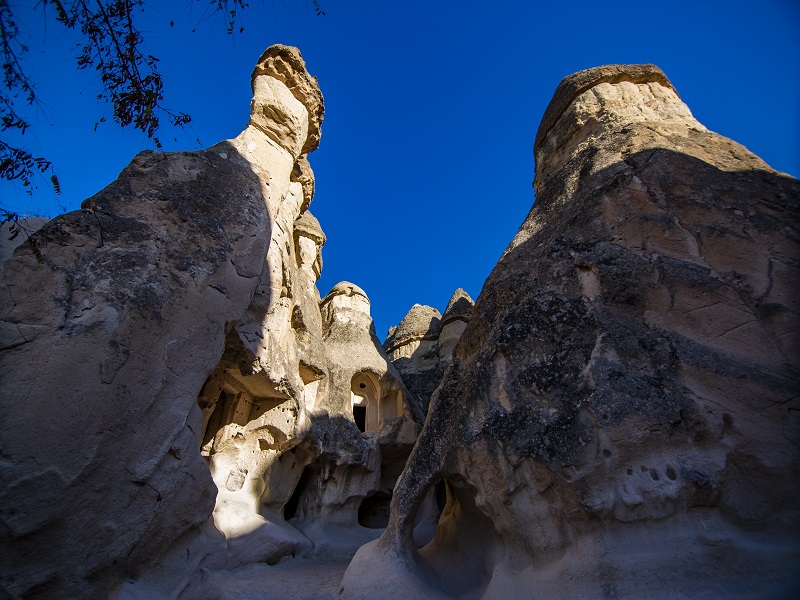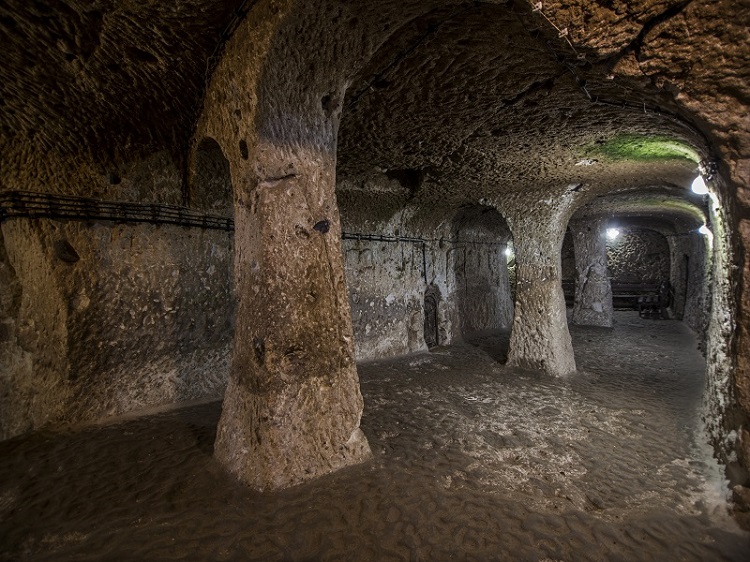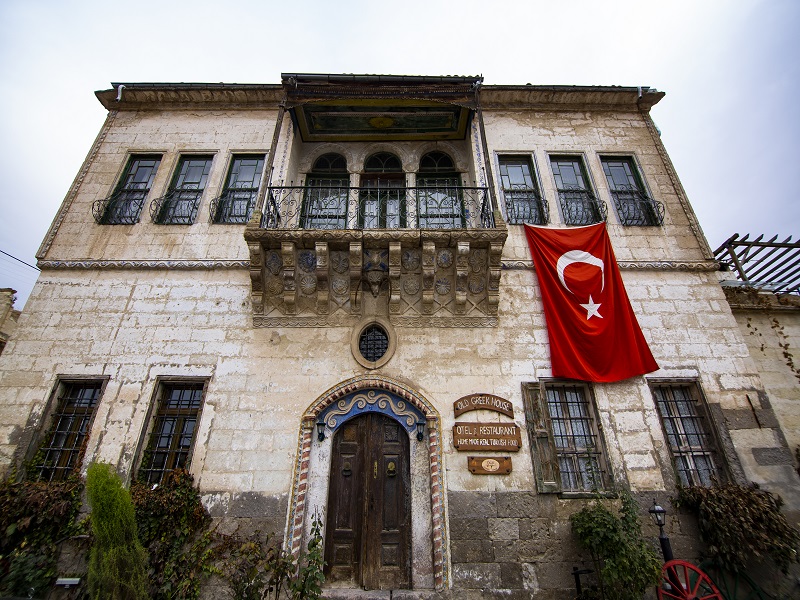Cappadocia Faith Route - 4 (Islam)
- A
- Ürgüp
- Ürgüp Temenni Hill Ürgüp Temenni Hill is one of the must-visit locations in Cappadocia, with its unique ruins and its ability to possess the Cappadocia landscape. The hill, which is located in the center of Ürgüp and is one of the first destinations that comes to mind when it comes to panoramic viewing of Cappadocia, is located at an altitude of 80 meters. Attracting the attention of local and foreign tourists, Temenni Hill is a popular destination for those who want to wish and photograph the beauty of Cappadocia. There is no vehicle to go to the hill, vehicles must be parked near Cami Kebir. The scenery witnessed even while climbing up Temenni Hill is simply fascinating. There is also a very important feature that makes Ürgüp Temenni Hill special. Kılıçarslan Tomb is located on this hill. There are also mausoleums in the tomb, which was opened to visitors in 2013 after necessary arrangements were made. Seljuk sultans who escaped from throne fights and Mongol raids and took refuge in Ürgüp are thought to have been captured and killed in the area.. On the western slope of the hill is the St. Georgios Church. Although all the walls of this ruin have been demolished and only the carving hall remains, this work is still worth seeing. Ürgüp Grand Mosque Both natural beauties and historical ruins fascinate those who come to Cappadocia. While the historical artifacts built in different periods complement the texture of the region, it continues to be the center of attention of local and foreign tourists. Ürgüp Grand Mosque is also among the must-visit destinations in Cappadocia. Ulu Mosque and Madrasa, built by Karamanlı Taşkın Pasha as a reflection of the tradition of the Ulu Mosque from the Seljuks, has survived to this day. There is no exact information about the architect of the building built on a square-like plan. There are two tombs in the courtyard of the mosque and one of the tombs is known to belong to Karamanlı Taşkın Pasha. There are many locations in Cappadocia that those who are excited about culture and faith tourism can visit except the Ürgüp Grand Mosque. Cappadocia, which has hosted many different civilizations since ancient times and has important destinations for Muslims as well as Christians, makes every step a new discovery. If you turn your route to Cappadocia, you can see the unique Cappadocia artifacts closely and experience a holiday experience that is impossible to forget in a lifetime.Read More
- Nasıl
Giderim ?
- B
- Mustafapaşa Grand Mosque
- It is on Mehmet Şakirpaşa Street in the Davutlu neighborhood of the Mustafapaşa town of Ürgüp district. The oldest of the three mosques built by Muslims in the town is the 'Cami-i Kebir (Grand Mosque)', dated 1601. The modest stone fountain under the Cami-i Kebir, named after Mustafa Pasha, who brought water to the village in the early 1800s (and hence the name of the village in the second half of the 1920s), was relocated during the repair. When the housing texture around the Sipahi Mosque (1834) and Şeyh Ali Mosque (1802) is examined, traces of Islamic culture can be seen, especially in the interior decorations. Source: http://www.turkiyenintarihieserleri.com/?oku=2302Read More
- Nasıl
Giderim ?
- C
- Taşkınpaşa Madrasah
- Taşkınpaşa Madrasah was built during the period of Karamanoğulları Principality. Although the date of its construction is not known exactly, it is estimated that it was completed in the 13th century. The madrasa is located in Damsa Village, 20 km away from Ürgüp. Taskin Pasha Complex consists of the mosque, the madrasa and the tombs in the courtyard of the mosque. The mihrab, doors and windows of the mosque are built of smooth cut stones, and the walls are built with rubble stones. Although the upper cover has been completely destroyed, it is understood by the stairs to the left of the entrance that it has at least two floors. The rich stonework seen on the west side is in the classical Seljuk style. The main entrance door is completely decorated with geometric and floral motifs. The inscription that should be placed above the entrance is missing. To the right of the low arched entrance is the mosque of the madrasa. Like its mihrab, it is decorated with rich floral motifs. The upper part is decorated with palmettes and the double border with floral motifs. Taşkınpaşa Mosque's mihrab, which is exhibited in Ankara Ethnography Museum, made of walnut inlaid technique, is important because it is the only remaining wooden example. The architecture of the Anatolian Principalities has a unique interior and exterior appearance you can not witness in other geography that fascinates people all over the world.Read More
- Nasıl
Giderim ?
- D
- Arpacızade Tomb
- Oral sources tell that Arpacızade Mehmet Efendi, who lived in the 19th century, was born in Ürgüp and received his madrasa education in Kırşehir. Mehmet Şükrü Efendi, who was born in 1845 in Nar and served as mufti and deputy, and Hafız Osman (1860-1910) Efendi from İncesu-Hamurcu, are among the students of Arpacızade. Arpacızade Mehmet Efendi, who was a professor at the Arpacızade madrasah in Ürgüp, produced a handwritten copy of the 1841 dated Adalı Mustafa b Hamza's "Netaicü'l - Efkar Şerhü'l İzhar". Arpacızade Mehmet Efendi, who moved and settled in Demirtaş village of Ürgüp, died in this village and was buried in the old cemetery. Since the writing of the tombstone inscription has been erased and corrupted, the entire inscription cannot be read. Source: H. Hüsetin DilaverRead More
- Nasıl
Giderim ?
- E
- Turesan Veli Tomb
- Located on Tekke Mountain, south of the center of İncesu, on the route that goes from İncesu to Başdere Town and then to Ürgüp, which is named Ulu Yol according to the charter, at the end of the secondary road that diverges 1 km north of this road, again according to the records of the foundation, the zaviye is located in Sultanım locality today. It is the only example remaining from the 17th century Seljuk era. As for the structure of the zawiya, there is a long hall in the middle, a tomb and a masjid on the left, a cell and a kitchen on the right, when you enter the building, which was built with small size cut stones supplied from the surrounding area, through the low-arched gateway. There is a small symbolic dome in the middle of the ceiling formed by the original stone steps leading to the roof from the right of the hall and the vault supported by two reinforced arches. The ceilings of all other sections are vaulted. There is a chat room at the end of the hall. The mosque mihrab is original with its simple stone decoration. The sarcophagus in the tomb was built as a masonry and was built later. There is no inscribed tombstone. On the right of the sentence door, the inn, which covers the north of the lodge from one end to the other, is passed through a vaulted entrance. This place later became a cemetery.Read More
- Nasıl
Giderim ?
The Most Popular Routes in Cappadocia
 Loading...
Loading...






 cappadocia
cappadocia




